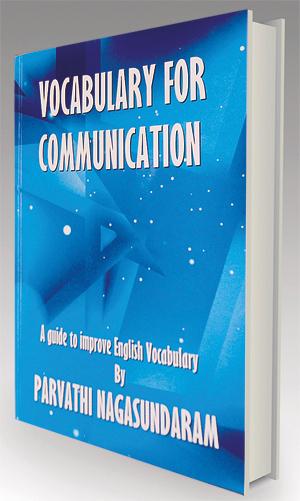Reply To:
Name - Reply Comment
‘Vocabulary for Communication’: A Guide to Improve English Vocabulary’ is the third book launched by Parvathi Nagasundaram. According to her, this book has been designed for students to improve their knowledge of their vocabulary in English, so that they would be able to communicate in English effectively and confidently. It was said that if one masters the grammar and vocabulary of a language, he or she will be able to master the language. The book was dedicated to Nagasundaram’s sister, the late former principal of Kopay Teachers’ College, Mrs. Rathilakshmi Ananthakumarasamy.
to improve their knowledge of their vocabulary in English, so that they would be able to communicate in English effectively and confidently. It was said that if one masters the grammar and vocabulary of a language, he or she will be able to master the language. The book was dedicated to Nagasundaram’s sister, the late former principal of Kopay Teachers’ College, Mrs. Rathilakshmi Ananthakumarasamy.
The following aspects of vocabulary have been included in this book: Spelling, pronunciation, inferring Vocabulary meaning, collocational appropriacy, word formation and words in English that may cause confusion in the user of the language. In addition, the book contains units on using the dictionary efficiently, word categories, phrasal verbs, English idioms, binomials and proverbs in English. Another salient feature of this book is the inclusion of spelling rules, discourse markers and solutions to the activities, included in the publication itself.
Author Nagasundaram is a retired senior lecturer in English from the University of Sri Jayawardenepura and the former head of the English Department. Moreover, she was involved in
|
The writer of the book Vocabulary For Communication. A Guide to Improve English Vocabulary, Parvathi Nagasundaram |
English language teaching for over 61 years. She is also the author of Essential Grammar and the book ‘Grammar for Communication’. The author’s insights: unveiling the heart of the book, the author mentioned that if one is to master their language one has to master their vocabulary and grammar which are the backbones of any language.
“Vocabulary is a neglected criterion in schools. There’s no systematic teaching of English vocabulary. It’s about knowing a word’s pronunciation, spelling, its full meaning, other meanings and the ability to use the word in a grammatically correct way with the necessary connoted words,” explained Nagasundaram. She underscored that idioms are included to help increase one’s fluency in English. Almost all sub-topics are discussed under the main topics. She added the reason for categorization is to make the students remember better. “Proverbs is a section that is forgotten at present. Not only English proverbs, but proverbs from all around the world are included in this book.
“Without grammar, very little can be conveyed; without vocabulary, nothing can be conveyed,” said Senior Lecturer of the Faculty of Humanities, department of English at the University of Kelaniya (UOK) Dinali Fernando while delving into the pages of the book. She said that the writing style effectively captures the nature of the book. She said that the book highlights the use of the dictionary. The book reflects the clarity and consciousness of the writer. The activities in the book create a learning environment as well as a self-teaching and practice environment. The book has a good flow where it starts with minor topics and gradually engages into the hardest parts. The part Binomials (Idiomatic Expressions) have drawn Fernando’s attention as society is unaware of them. She continued by saying that the book contains the informal and formal use of vocabulary; which helps the reader to understand the language.
An analysis of the book, in the eyes of the reader, was provided by Senior Lecturer, Gampaha Wickramarachchi University of Indigenous Medicine and Dr. Palitha Dissanayake. He pointed out that this book is a significant and unique contribution to second language teaching in Sri Lanka.
There are more books written based on grammar, but this is unique for its vocabulary production. He emphasised that this book has offered spaces where the learner is capable of practising, which is a usual absent aspect in other books. He used an example from the book to view the reader’s perspective. It was mentioned that in the first lesson, Phrasal verbs have more than 10 activities. Learners are allowed to discover effective vocabulary development strategies; Inferring by the contextual clues is a topic discussed in the book.
